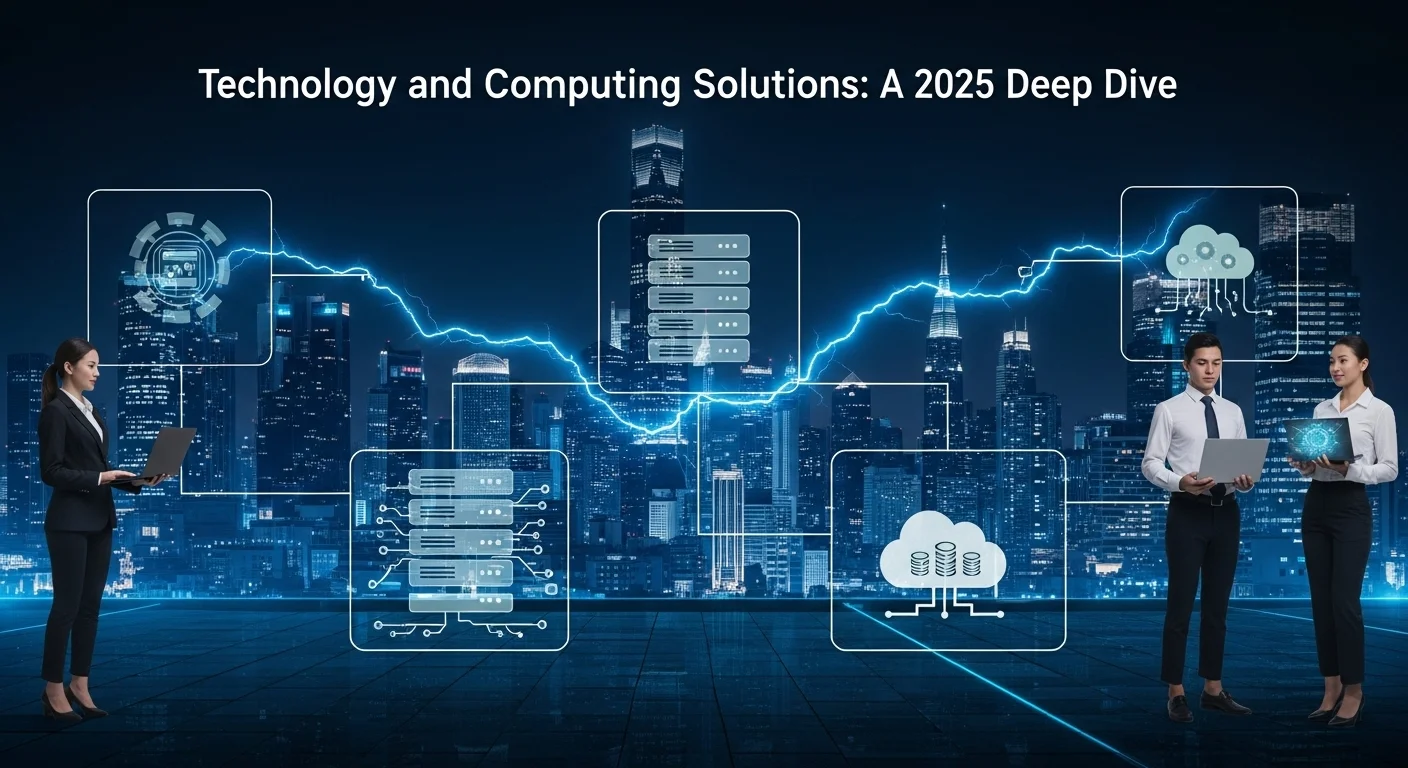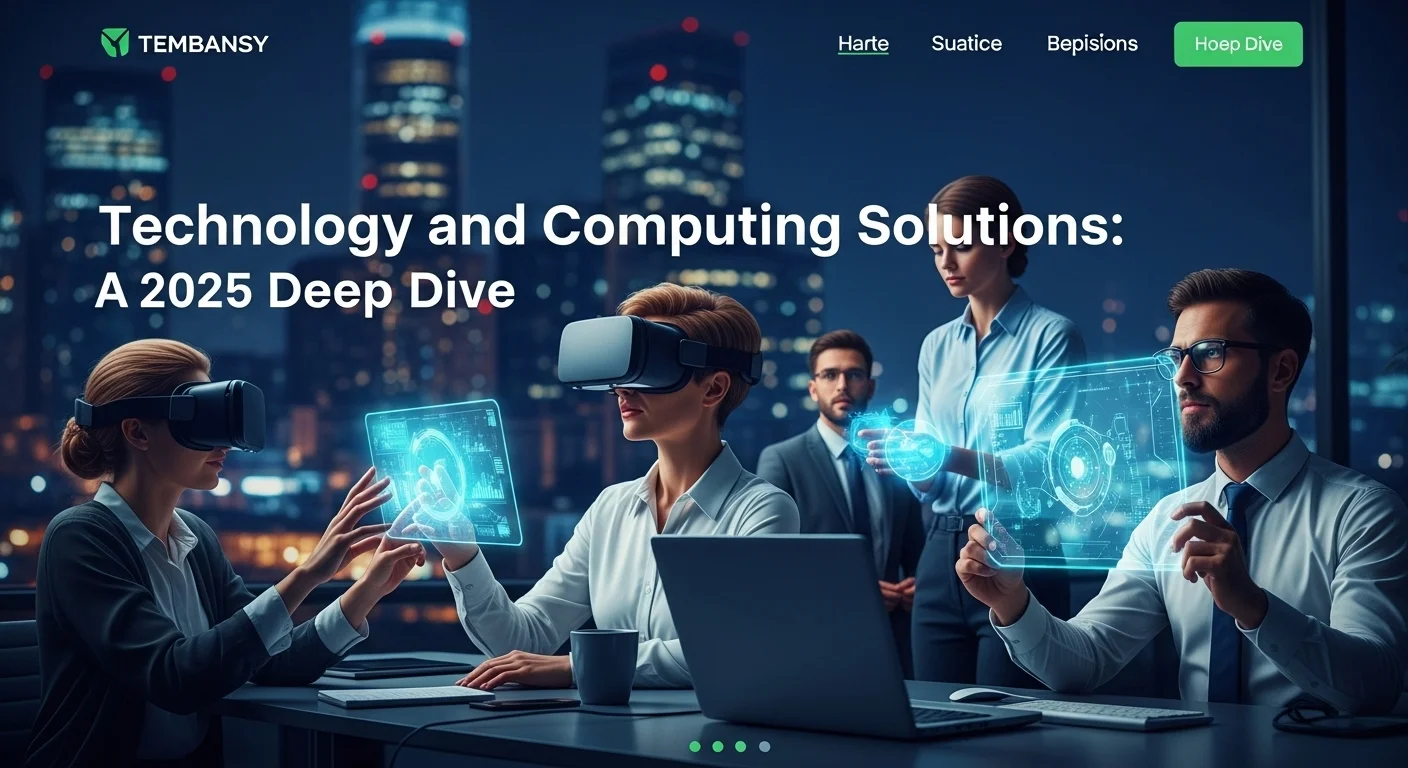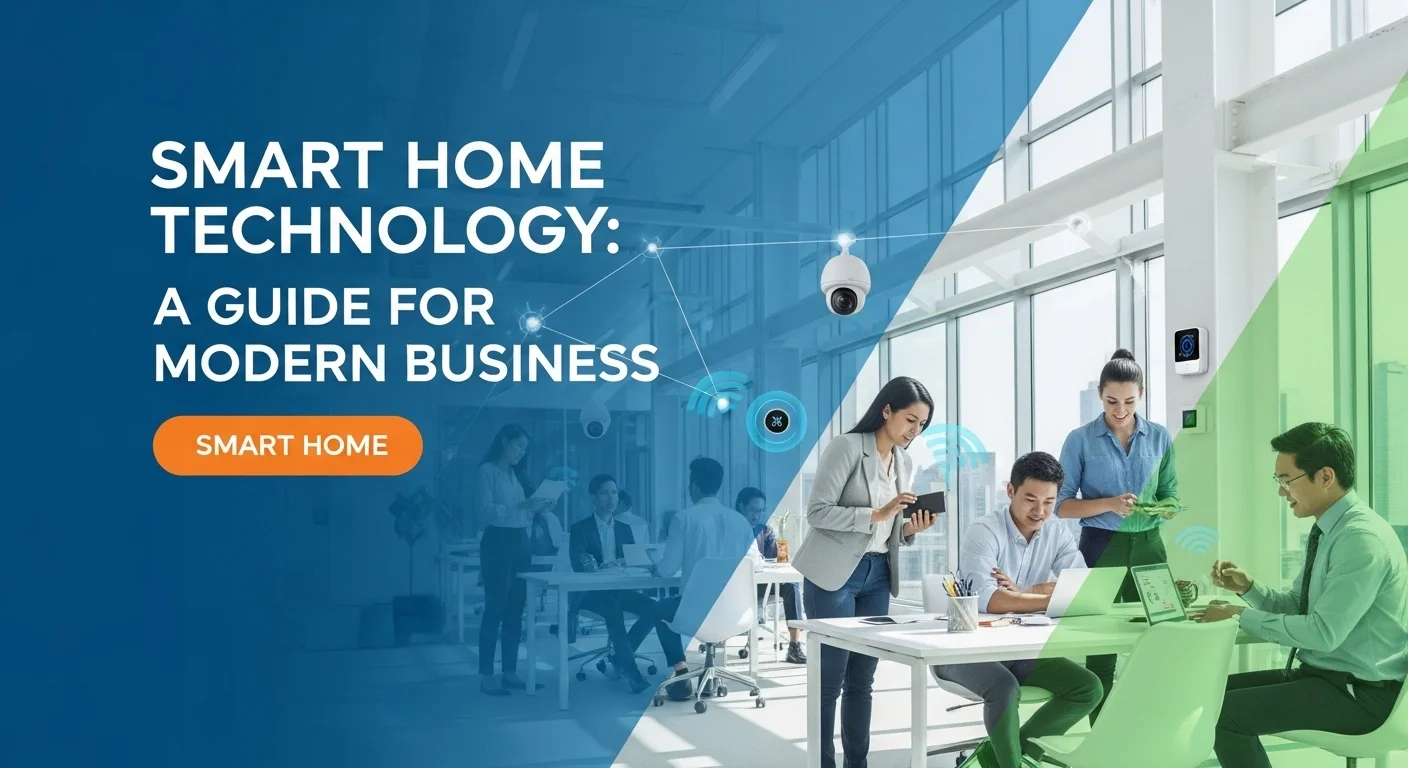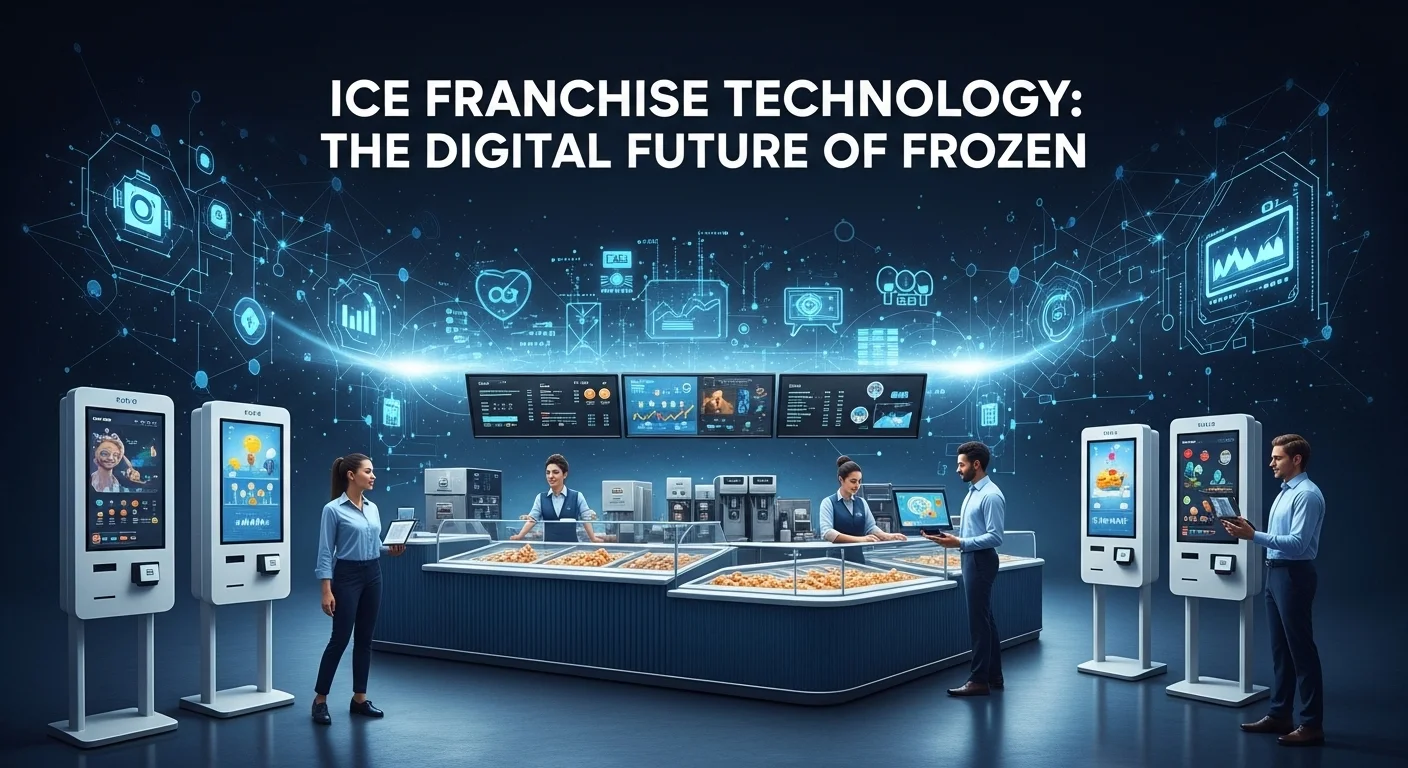Computing Solutions Demystified: Your 2025 Guide to Cloud, Security, and Growth

Executive Summary
Ever feel like the world of tech is moving too fast? You're not alone. The term 'computing solutions' sounds complex, but it's the engine behind every successful modern business. In my years as a cloud strategist, I've seen companies transform by getting this one thing right. This guide is designed to cut through the noise. We'll walk through the essentials of cloud technology, making sense of things like IaaS, PaaS, and SaaS with simple analogies. We'll explore how to choose between public, private, and hybrid clouds to match your specific needs. More importantly, we’ll tackle security head-on, because growing your business on the cloud should feel safe, not risky. Think of this as your personal roadmap to making smart, confident technology decisions that will truly move the needle for your business.
Table of Contents
Table of Contents
What is a Computing Solution and Why Should You Care?
Let's be honest, 'Computing Solutions' sounds like a term straight out of a corporate IT handbook. But behind the jargon is a simple idea that powers nearly everything we do digitally. At its heart, a computing solution is just a mix of tools—hardware, software, and networks—that work together to get a job done. It could be as simple as your laptop running spreadsheet software or as vast as the global network of servers that lets you binge-watch your favorite show. In my experience, understanding this isn't just for tech gurus; it's fundamental for anyone wanting to run a business or innovate today. Without them, the modern economy would simply stop.
The journey here has been incredible. I remember the days of giant mainframe computers locked away in basements. Then came the personal computer, which brought computing to our desks. But the real game-changer was the internet, which paved the way for cloud computing. This shift changed everything. Instead of buying and maintaining massive servers ourselves, we can now essentially 'rent' computing power from providers. This is the core of modern cloud computing and solutions, and it’s arguably the biggest leap in technology since the PC itself.
The Rise of the Cloud: A New Era for Computing
Cloud computing isn't just a piece of technology; it’s a whole new way of doing business. It allows you to access everything from storage and databases to complex applications over the internet. To make it simple, I like to think of it like building a house. You have three main options:
- Infrastructure as a Service (IaaS): This is like renting a plot of land and the basic utilities. You get the fundamental building blocks—servers, storage, networking—but you're in charge of building the house (your platform and applications) yourself. It offers the most control, which is why companies with massive, unique needs like Netflix use AWS to build their streaming empire from the ground up. [27]
- Platform as a Service (PaaS): This is like renting a newly built house, but you have to furnish it. The provider manages the foundation, walls, and roof (the servers, storage, and databases), so your developers can focus purely on creating and running your applications—the furniture and decor. It's built for speed and convenience.
- Software as a Service (SaaS): This is like renting a fully furnished, all-inclusive apartment. You just sign up and start using the software. The provider handles everything from the servers to software updates and security. Think of everyday tools like Salesforce, Dropbox, or Google Workspace—they're all SaaS. [5, 27]
The beauty of these models is how they shift your spending. Instead of a huge upfront investment in hardware (Capital Expenditure), you pay as you go (Operational Expenditure), which gives businesses incredible financial flexibility. [20]
Deployment Models: Public, Private, and Hybrid Clouds
Once you've chosen a service model, you need to decide where your cloud will live. The main cloud solutions in cloud computing deployment models are:
- Public Cloud: This is the most common model, where you use services from a provider like Amazon Web Services (AWS), Microsoft Azure, or Google Cloud. They own and manage all the infrastructure. It's like living in a massive apartment complex with endless amenities—incredibly scalable and cost-effective. [4]
- Private Cloud: This is a cloud environment dedicated exclusively to your organization. It can be in your own data center or hosted by a third party. Think of it as your own private, single-family home with a big fence around it. It offers maximum control and security, which is why it's a favorite for government agencies and financial institutions. [23]
- Hybrid Cloud: You guessed it—this model combines public and private clouds. [4, 9] I've helped many businesses set up hybrid cloud computing solutions to keep their most sensitive data secure in their private cloud while using the public cloud's power and scale for things like web traffic or big data analytics. [10] This allows for 'cloud bursting,' where you can spill over into the public cloud during unexpected demand spikes. [4]
The Critical Importance of Enterprise and Security Solutions
For bigger companies, the conversation naturally turns to enterprise cloud computing solutions. These aren't just about more power; they’re about sophisticated tools for security, compliance, and governance that large organizations need to operate globally. [18] The goal is to be more agile, cut costs, and innovate faster with integrated AI and machine learning tools. [3, 18]
But none of this matters if it isn't secure. As we move online, security becomes the number one job. Think of cloud computing security solutions as the locks, alarms, and security guards for your digital assets. It's a must-have, not a nice-to-have. A solid security plan includes:
- Identity and Access Management (IAM): This is your digital bouncer, ensuring only the right people get in. It's about giving employees access only to what they need to do their job, and nothing more. [2, 14]
- Data Encryption: This scrambles your data so it's unreadable to anyone without the key. It's essential for protecting data when it's stored (at rest) and when it's moving (in transit). [7, 12]
- Network Security: This means setting up digital firewalls and monitoring your network traffic for suspicious activity, just like having security cameras around your property. [14]
- Compliance and Governance: If you're in an industry like healthcare or finance, you have strict rules to follow (like HIPAA or GDPR). Cloud platforms provide tools to help you meet these rules, but ultimately, keeping your house in order is your responsibility. [12]
In short, the cloud has opened up a world of possibilities. By understanding these core concepts—from service models to security protocols—you can make informed decisions that empower your business to not just compete, but to lead in the digital age.

Your Complete Guide to Choosing the Right Solutions in Technology and Business
Alright, you understand the 'what' and the 'why.' Now comes the exciting part: picking the right tools for the job. Over the years, I've learned that this process is less about the technology itself and more about deeply understanding your business goals. Are you trying to move faster, cut costs, or create a better customer experience? Let's walk through how to translate those goals into a solid tech strategy.
Choosing the Right Cloud Provider and Service Model
The cloud world has its titans: Amazon Web Services (AWS), Microsoft Azure, and Google Cloud Platform (GCP). Think of them like different high-end grocery stores. They all have amazing ingredients, but some are famous for specific things. AWS is the oldest and largest, with a staggering range of services for almost any need. [11] Azure is a powerhouse in the corporate world, especially if your business already runs on Microsoft products. GCP shines when it comes to data, analytics, and machine learning. Your choice should feel natural, aligning with your team's skills and your long-term vision.
After you have a provider in mind, you select your service model (IaaS, PaaS, or SaaS). It all comes down to a simple trade-off: control versus convenience.
- Go with IaaS if: You need total control. You want to build from the ground up or move existing systems to the cloud without major changes. It's for the hands-on IT teams.
- Go with PaaS if: You want to build apps, not manage infrastructure. It’s a developer's dream, letting them focus on creating amazing software without worrying about the plumbing.
- Go with SaaS if: You need a ready-to-go solution for a business need like sales (Salesforce), collaboration (Google Workspace), or storage (Dropbox). [5, 27] It's the simplest path, with the least management required.
Architecting for Success: A Deep Dive into Hybrid Cloud
For many businesses I've worked with, the magic isn't in choosing one cloud, but in blending them. This is the essence of hybrid cloud computing solutions. A smart hybrid plan connects your private, on-site systems with the public cloud, letting you shift work between them. [4, 9, 19] This gives you the best of both worlds: the fortress-like security of a private cloud for your most sensitive data, and the massive scale and affordability of the public cloud for everything else. [4, 10]
Building a great hybrid setup involves a few key steps:
- Solid Connectivity: You need a secure, reliable bridge between your private and public clouds. This can be a VPN or a dedicated, high-speed line like AWS Direct Connect or Azure ExpressRoute.
- Unified Management: You don't want to juggle two separate systems. Tools like Google Cloud's Anthos or Azure Arc give you a single dashboard to manage everything, no matter where it lives. [9]
- Smooth Data Flow: Your data needs to move seamlessly between clouds. This requires a smart strategy to keep everything synchronized and available.
From a business standpoint, a hybrid approach is incredibly flexible. You can use the public cloud for development and testing, firing up servers when you need them and shutting them down to save money. It's also a fantastic strategy for disaster recovery. This flexibility is what allows you to innovate like a startup while maintaining the security of an established enterprise. [4]
The Imperative of Cloud Security: Beyond the Basics
I can't stress this enough: security must be your top priority from day one. Implementing robust cloud computing security solutions is a partnership. The cloud provider secures their infrastructure, but you are responsible for securing everything you put inside it—your data, your applications, and who has access to them.
Here are some technical methods I always recommend:
- Adopt a 'Zero Trust' Mindset: The motto here is 'never trust, always verify.' [2, 7] Every single request to access your resources must be authenticated and authorized, even if it's coming from inside your own network. This stops intruders from moving around freely if they ever get inside. [14]
- Automate Your Defenses: Humans make mistakes. Automation doesn't. Automate security tasks like patching, configuration checks, and compliance monitoring to maintain a consistently strong defense. Misconfigurations are one of the top causes of data breaches, and automation helps eliminate them. [2]
- Encrypt Everything, Everywhere: Data is valuable. Encrypt it while it's being stored and while it's moving across the internet. [7, 12] For your most critical information, take control of your own encryption keys using a Key Management Service (KMS) or a Hardware Security Module (HSM). [7, 14]
- Be a Watchful Guardian: Implement 24/7 monitoring and logging for all your cloud services. [2] Use smart tools that can detect unusual behavior and alert you to potential threats in real time. Having a plan ready for when an incident occurs is just as critical. [2]
Building a security-first culture in your company is just as important as the technology. Train everyone on security best practices. By making security a shared responsibility, you're not just protecting data; you're building trust with your customers and safeguarding your reputation.
Comparing and Contrasting Cloud Solutions
When you're evaluating different cloud solutions in cloud computing, use a simple framework to compare your options:
- Cost: Look beyond the sticker price. Compare pay-as-you-go rates, long-term discounts, and use cost management tools to predict your spending.
- Performance: Does it meet your speed and reliability needs? Run tests and pilots to see how different services perform with your actual workloads.
- Scalability: How quickly and easily can you scale up or down? Look for auto-scaling features that adjust automatically to traffic. [16]
- Security & Compliance: Does the provider meet your industry's standards? Deeply investigate their security features and certifications. [10]
- Service Level Agreements (SLAs): What uptime do they guarantee? Understand their commitment and what happens if they don't meet it.
By following a structured approach, you can turn a complex decision into a clear choice. The right computing solution is more than just infrastructure; it's a strategic asset that unlocks innovation and gives you a powerful competitive edge.

Tips and Strategies for Mastering Your Tech Experience with Computing Solutions
So, you've moved into your new 'cloud house.' The work isn't over—it's just beginning. In my experience, truly mastering the cloud is an ongoing process of tuning, optimizing, and learning. It’s about living in your new digital space efficiently and safely. This section is packed with practical tips I've gathered over the years to help you manage costs, boost performance, tighten security, and prepare for what's next. These are essential whether you're managing massive enterprise cloud computing solutions or just starting your cloud journey.
Best Practices for Cloud Cost Management (FinOps)
The cloud's biggest promise is cost-efficiency, but I've seen too many businesses get a shocking bill at the end of the month because they left all the digital 'lights' on. FinOps, or Cloud Financial Management, is all about bringing financial discipline to your cloud spending.
- Tag Everything: This is my number one rule. Apply 'tags' (metadata labels) to every single cloud resource. Tag by project, department, or team. This gives you crystal-clear visibility into who is spending what, which is the first step to controlling costs.
- Use Discounts for Predictable Work: If you have servers that run 24/7, don't pay the on-demand price. Commit to a one- or three-year plan with Reserved Instances (RIs) or Savings Plans. The discounts are significant and can drastically lower your bill.
- Right-Size and Automate Shutdowns: Most teams over-provision servers 'just in case.' Continuously monitor your usage and downsize those oversized, underused machines. Also, automate scripts to shut down development and testing environments overnight and on weekends. You shouldn't pay for resources that are sitting idle.
- Hunt Down 'Zombie' Assets: Regularly scan for orphaned resources—things like unattached storage volumes or forgotten load balancers that are no longer being used but are still racking up charges. Terminate them without mercy!
Strategies for Optimizing Performance
Great cloud performance isn't just about raw speed. It's about delivering a smooth, reliable experience for your users without overspending. This means choosing the right cloud computing and solutions for each specific job.
- Match the Tool to the Task: Cloud providers offer a dizzying array of machine types and storage options. Don't use a generic server for a memory-intensive database. Choose compute-optimized, memory-optimized, or storage-optimized instances. Use high-speed SSD storage for active databases and low-cost object storage for archives.
- Use a Content Delivery Network (CDN): If you have a global user base, a CDN is non-negotiable. It stores copies of your content in locations all around the world, so users get data from a server near them, not one halfway across the planet. It's how services like Netflix deliver seamless streaming. [15]
- Design for Failure: In the cloud, you have to assume things will eventually fail. Build resilient applications by spreading them across multiple Availability Zones (separate data centers). Use auto-scaling to automatically handle traffic spikes, ensuring your app stays responsive under pressure.
- Go Cloud-Native: For new projects, think in terms of microservices and containers (like Docker and Kubernetes). Instead of one giant, monolithic application, you build many small, independent services. This makes your system more resilient, easier to update, and simpler to scale. [3]
Hardening Your Security with Advanced Practices
Basic security is good, but proactive defense is better. As threats become more sophisticated, your security strategy must evolve, especially when you're managing data across hybrid cloud computing solutions.
- Become a Threat Hunter: Don't just wait for alarms to go off. Proactively search for threats in your systems. Use threat intelligence feeds and advanced analytics to look for subtle signs of compromise before a full-blown attack occurs.
- Layer Your Defenses: A modern security plan needs multiple layers. This includes Web Application Firewalls (WAFs) to block common web attacks, Intrusion Detection Systems (IDS) to monitor network traffic for malicious behavior [2], and Data Loss Prevention (DLP) tools to stop sensitive data from leaving your network. [23]
- Secure Your Supply Chain: Your code is your asset. Scan all open-source libraries and container images for vulnerabilities before they ever get deployed. Digitally sign your software to ensure it hasn't been tampered with.
- Run Fire Drills: Regularly hire ethical hackers for penetration tests and run internal security drills. [12] This is the best way to find your weak spots and make sure your team is ready to respond when a real incident happens.
Looking to the Future: Emerging Technologies
The tech world never stands still. Keeping an eye on the horizon is key to staying competitive. Here are a few trends that are shaping the future of cloud solutions in cloud computing.
- Serverless Computing: This is the next step in cloud evolution. With platforms like AWS Lambda or Azure Functions, you can run your code without thinking about servers at all. You only pay for the exact compute time you use. It's incredibly efficient for certain types of applications. [6]
- Edge Computing: With the explosion of IoT devices, it makes more sense to process data closer to where it's created, rather than sending it all to a central cloud. Edge computing reduces latency and is essential for real-time applications like self-driving cars and smart factories. [6, 17]
- AI and Machine Learning Everywhere: AI/ML are becoming standard features in cloud platforms. [3, 8] Providers are making it easier than ever to integrate AI into your applications, allowing you to automate processes, analyze data, and build predictive models with powerful, pre-built tools.
By adopting these strategies, you can transform the cloud from a utility into your most powerful strategic weapon. For those who want to dive even deeper, I always recommend following Gartner's research on IT and cloud trends. Continuous learning and optimization are the keys to unlocking the true potential of technology for your business.
Expert Reviews & Testimonials
Sarah Johnson, Business Owner ⭐⭐⭐⭐⭐
As a small business owner, the cloud always seemed intimidating. This article finally broke it down in a way that makes sense. The section on choosing the right service model was a game-changer for me.
Mike Chen, IT Consultant ⭐⭐⭐⭐⭐
Solid overview. I'm an IT consultant, and I'll be sharing this with clients who need a clear, no-nonsense explanation of hybrid clouds. Well-written and cuts through the marketing fluff.
Emma Davis, Tech Student ⭐⭐⭐⭐⭐
Finally, an article that connects all the dots! The analogies for IaaS, PaaS, and SaaS were the clearest I've ever read. This is a must-read for any tech professional or student.



